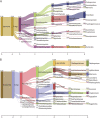Factors Influencing Distribution of Coccidioides immitis in Soil, Washington State, 2016
- PMID: 34730378
- PMCID: PMC8565518
- DOI: 10.1128/mSphere.00598-21
Factors Influencing Distribution of Coccidioides immitis in Soil, Washington State, 2016
Abstract
Coccidioides immitis and Coccidioides posadasii are causative agents of Valley fever, a serious fungal disease endemic to regions with hot, arid climate in the United States, Mexico, and Central and South America. The environmental niche of Coccidioides spp. is not well defined, and it remains unknown whether these fungi are primarily associated with rodents or grow as saprotrophs in soil. To better understand the environmental reservoir of these pathogens, we used a systematic soil sampling approach, quantitative PCR (qPCR), culture, whole-genome sequencing, and soil chemical analysis to identify factors associated with the presence of C. immitis at a known colonization site in Washington State linked to a human case in 2010. We found that the same strain colonized an area of over 46,000 m2 and persisted in soil for over 6 years. No association with rodent burrows was observed, as C. immitis DNA was as likely to be detected inside rodent holes as it was in the surrounding soil. In addition, the presence of C. immitis DNA in soil was correlated with elevated levels of boron, calcium, magnesium, sodium, and silicon in soil leachates. We also observed differences in the microbial communities between C. immitis-positive and -negative soils. Our artificial soil inoculation experiments demonstrated that C. immitis can use soil as a sole source of nutrients. Taken together, these results suggest that soil parameters need to be considered when modeling the distribution of this fungus in the environment. IMPORTANCE Coccidioidomycosis is considered a highly endemic disease for which geographic range is likely to expand from climate change. A better understanding of the ecological niche of Coccidioides spp. is essential for generating accurate distribution maps and predicting future changes in response to the changing environment. Our study used a systematic sampling strategy, advanced molecular detection methods, and soil chemical analysis to identify environmental factors associated with the presence of C. immitis in soil. Our results demonstrate the fungus can colonize the same areas for years and is associated with chemical and microbiological soil characteristics. Our results suggest that in addition to climate parameters, soil characteristics need to be considered when building habitat distribution models for this pathogen.
Keywords: Coccidioides; Valley fever; coccidioidomycosis.
Figures




Comment in
-
The Association between Coccidioides immitis and Rodent Habitats in Washington State Remains Unresolved.mSphere. 2022 Aug 31;7(4):e0029422. doi: 10.1128/msphere.00294-22. Epub 2022 Jul 11. mSphere. 2022. PMID: 35862806 Free PMC article. No abstract available.
Similar articles
-
Valley fever: finding new places for an old disease: Coccidioides immitis found in Washington State soil associated with recent human infection.Clin Infect Dis. 2015 Jan 1;60(1):e1-3. doi: 10.1093/cid/ciu681. Epub 2014 Aug 27. Clin Infect Dis. 2015. PMID: 25165087 Free PMC article.
-
Local Population Structure and Patterns of Western Hemisphere Dispersal for Coccidioides spp., the Fungal Cause of Valley Fever.mBio. 2016 Apr 26;7(2):e00550-16. doi: 10.1128/mBio.00550-16. mBio. 2016. PMID: 27118594 Free PMC article.
-
Real-time PCR assay for detection and differentiation of Coccidioides immitis and Coccidioides posadasii from culture and clinical specimens.PLoS Negl Trop Dis. 2021 Sep 16;15(9):e0009765. doi: 10.1371/journal.pntd.0009765. eCollection 2021 Sep. PLoS Negl Trop Dis. 2021. PMID: 34529679 Free PMC article.
-
From soil to clinic: current advances in understanding Coccidioides and coccidioidomycosis.Microbiol Mol Biol Rev. 2024 Dec 18;88(4):e0016123. doi: 10.1128/mmbr.00161-23. Epub 2024 Oct 4. Microbiol Mol Biol Rev. 2024. PMID: 39365073 Review.
-
Molecular markers in the epidemiology and diagnosis of coccidioidomycosis.Rev Iberoam Micol. 2014 Jan-Mar;31(1):49-53. doi: 10.1016/j.riam.2013.09.011. Epub 2013 Nov 20. Rev Iberoam Micol. 2014. PMID: 24270069 Review.
Cited by
-
The Geographic Distribution of Dimorphic Mycoses in the United States for the Modern Era.Clin Infect Dis. 2023 Apr 3;76(7):1295-1301. doi: 10.1093/cid/ciac882. Clin Infect Dis. 2023. PMID: 36366776 Free PMC article.
-
Coccidioidomycosis: A Contemporary Review.Infect Dis Ther. 2022 Apr;11(2):713-742. doi: 10.1007/s40121-022-00606-y. Epub 2022 Mar 1. Infect Dis Ther. 2022. PMID: 35233706 Free PMC article. Review.
-
Diagnosis and Treatment of Pulmonary Coccidioidomycosis and Paracoccidioidomycosis.J Fungi (Basel). 2023 Feb 7;9(2):218. doi: 10.3390/jof9020218. J Fungi (Basel). 2023. PMID: 36836333 Free PMC article. Review.
-
Risk of Exposure to Coccidioides spp. in the Temblor Special Recreation Management Area (SRMA), Kern County, CA.Microorganisms. 2023 Feb 17;11(2):518. doi: 10.3390/microorganisms11020518. Microorganisms. 2023. PMID: 36838483 Free PMC article.
-
Update on the Epidemiology, Diagnosis, and Treatment of Coccidioidomycosis.J Fungi (Basel). 2022 Jun 25;8(7):666. doi: 10.3390/jof8070666. J Fungi (Basel). 2022. PMID: 35887423 Free PMC article. Review.
References
-
- McCotter OZ, Benedict K, Engelthaler DM, Komatsu K, Lucas KD, Mohle-Boetani JC, Oltean H, Vugia D, Chiller TM, Sondermeyer Cooksey GL, Nguyen A, Roe CC, Wheeler C, Sunenshine R. 2019. Update on the epidemiology of coccidioidomycosis in the United States. Med Mycol 57:S30–S40. doi:10.1093/mmy/myy095. - DOI - PMC - PubMed
-
- Barker BM. 2018. Coccidioidomycosis in animals, p 81–114. In Sybren de Hoog G, Guillot J, Verweij PE, Seyedmousavi S (ed), Emerging and epizootic fungal infections in animals. Springer, Cham, Switzerland.
-
- Marsden-Haug N, Hill H, Litvintseva AP, Engelthaler DM, Driebe EM, Roe CC, Ralston C, Hurst S, Goldoft M, Gade L, Wohrle R, Thompson GR, Brandt ME, Chiller T, Centers for Disease Control and Prevention (CDC) . 2014. Coccidioides immitis identified in soil outside of its known range–Washington, 2013. MMWR Morb Mortal Wkly Rep 63:450. - PMC - PubMed
MeSH terms
Substances
LinkOut - more resources
Full Text Sources
Medical
Miscellaneous
